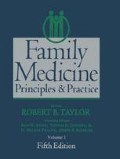Abstract
Family physicians deal with a wide range of behavioral problems. The methods used to treat children are variable and require flexibility on the part of the family physician. This requirement is not surprising to the experienced physician, who is able to comfort a 3-year-old who sits on the mother’s lap as well as to chat about “cool” topics with the preteen. The methods to change behaviors, though, are derived from the principles of behavioral modification. In this chapter we examine several common behavioral problems of children. The diagnoses are defined according to the Diagnostic and Statistical Manual of Mental Disorders Fourth Edition (DSM-IV) 1 whenever possible. The physician must learn how to recognize when psychopathology is present and how to foster more adaptive behavior in family and school contexts.
Access this chapter
Tax calculation will be finalised at checkout
Purchases are for personal use only
Preview
Unable to display preview. Download preview PDF.
References
American Psychiatric Association. Diagnostic and statistical manual of mental disorders, 4th ed. Washington, DC: APA, 1994.
Novak LL. Childhood behavior problems. Am Fam Physician 1996;53:257–62.
Searight HR, Nahlik JE, Campbell DC. Attention-deficit/hyperactivity disorder: assessment, diagnosis, and management. J Fam Pract 1995;40:270–9.
Conners CK. Rating scales for use in drug studies with children. Psychopharmacol Bull 1973; special issue: psy-chopharmacology in children: 60.
Nahlik JE. New thoughts on attention-deficit/hyperactivity disorder. Hosp Pract 1995;30:70–2.
Jones C. Attention deficit disorder strategies for school age children. San Antonio, TX: Communication Skill Builders (Harcourt Brace, Psychological Corp), 1994.
Nahlik JE, Searight HR. Diagnosis and treatment of attention-deficit/hyperactivity disorder. Primary Care Rep 1996; 2(8):65–74.
Safer DJ. Major treatment considerations for attention-deficit hyperactivity disorder. Curr Probl Pediatr 1995;25: 137–13.
Sieg KG, Gaffney GR, Preston DF, Hellings JA. SPECT brain imaging abnormalities in attention deficit hyperactivity disorder. Clin Nucl Med 1995;20(l):55–60.
Fennell EB. The role of neuropsychological assessment in learning disabilities. J Child Neurol 1995;10(suppl):36–41.
Schwartz S, Johnson JH. Psychopathology of childhood: a clinical experimental approach. New York: Pergamon, 1985.
Loeber R. Antisocial behavior: more enduring than changeable? J Am Acad Child Adolesc Psychiatry 1991;30:393–7.
Zuckerman M. Beyond the sensation seeking motive. Hillsdale, NY: Erlbaum, 1979.
Farrington DP. Childhood aggression and adult violence: early precursors and later life outcomes. In: Pepier J, Rubin KH, editors. The development and treatment of childhood aggression. Hillsdale, NJ: Erlbaum, 1991:169–78.
Barkley R. Attention deficit hyperactivity disorder: a handbook for diagnosis and treatment. New York: Guilford, 1990.
Webster-Stratton C. Annotation: strategies for helping families with conduct disordered children. J Child Psychol Psychiatry 1991;32:1047–62.
Patterson GR. Coercive family processes. Eugene, OR: Cas-talia, 1982.
Kratchowill TR, Morris RJ. The practice of child therapy. 2nd ed. New York: Pergamon, 1991.
Rapoport JL, Leonare, HL, Swedo SE, Leane MC. Obsessive-compulsive disorder in children and adolescents: issues in management. J Clin Psychiatry 1993;54(suppl):27–9.
Hanna GL. Demographic and clinical features of obsessive-compulsive disorder in children and adolescents. J Am Acad Child Adolesc Psychiatry 1995;34:19–27.
Peterson AL, Campise RL, Azrin NH. Behavioral and pharmacological treatments for tic and habit disorders: a review. Dev Behav Pediatr 1994;15:430–41.
Leonard HL, Lenane MC, Swedo SE, Rettew DC, Rapoport JL. A double-blind comparison of clomipramine and desi-pramine treatment of severe onychophagia (nail biting). Arch Gen Psychiatry 1991;48:821–7.
Ferber R. Solve your child’s sleep problems. 1st Fireside ed. New York: Simon & Schuster, 1986.
Editor information
Editors and Affiliations
Rights and permissions
Copyright information
© 1998 Springer Science+Business Media New York
About this chapter
Cite this chapter
Nahlik, J.E., Searight, H.R. (1998). Behavioral Problems of Children. In: Taylor, R.B., David, A.K., Johnson, T.A., Phillips, D.M., Scherger, J.E. (eds) Family Medicine. Springer, New York, NY. https://doi.org/10.1007/978-1-4757-2947-4_19
Download citation
DOI: https://doi.org/10.1007/978-1-4757-2947-4_19
Publisher Name: Springer, New York, NY
Print ISBN: 978-1-4757-2949-8
Online ISBN: 978-1-4757-2947-4
eBook Packages: Springer Book Archive

